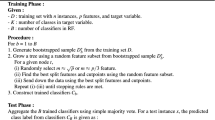Abstract
This article elaborates on the task of Human Activity Recognition being solved with the Random Forest algorithm. A performance measure is provided in terms of both recognition accuracy and computation speed. In addition, the Random Forest algorithm was implemented using CUDA, a technology providing options for massively parallel computations on low-cost hardware. The results suggest that Random Forest is a suitable and highly reliable technique for recognising human activities and that Graphics Processing Units can significantly improve the computation times of this otherwise rather time-consuming algorithm.
Access this chapter
Tax calculation will be finalised at checkout
Purchases are for personal use only
Similar content being viewed by others
References
Anguita, D., Ghio, A., Oneto, L., Parra, X., Reyes-Ortiz, J.L.: Human activity recognition on smartphones using a multiclass hardware-friendly support vector machine. In: Bravo, J., Hervás, R., Rodríguez, M. (eds.) IWAAL 2012. LNCS, vol. 7657, pp. 216–223. Springer, Heidelberg (2012)
Bańczyk, K., Kempa, O., Lasota, T., Trawiński, B.: Empirical comparison of bagging ensembles created using weak learners for a regression problem. In: Nguyen, N.T., Kim, C.-G., Janiak, A. (eds.) ACIIDS 2011, Part II. LNCS, vol. 6592, pp. 312–322. Springer, Heidelberg (2011)
Ben-Arie, J., Wang, Z., Pandit, P., Rajaram, S.: Human activity recognition using multidimensional indexing. IEEE Trans. Pattern Anal. Mach. Intell. 24(8), 1091–1104 (2002)
Bobick, A.F., Davis, J.W.: The recognition of human movement using temporal templates. IEEE Trans. Pattern Anal. Mach. Intell. 23(3), 257–267 (2001)
Breiman, L.: Random forests. Mach. Learn. 45(1), 5–32 (2001). http://dx.doi.org/10.1023/A%3A1010933404324
Breiman, L.: Random forests. Mach. Learn. 45(1), 5–32 (2001)
Cuzzocrea, A., Francis, S.L., Gaber, M.M.: An information-theoretic approach for setting the optimal number of decision trees in random forests. In: SMC, pp. 1013–1019 (2013)
Dabney, A.R.: Classification of microarrays to nearest centroids. Bioinformatics 21(22), 4148–4154 (2005)
Denil, M., Matheson, D., de Freitas, N.: Narrowing the gap: Random forests in theory and in practice. CoRR abs/1310.1415 (2013)
Dietterich, T.G.: Ensemble methods in machine learning. In: Kittler, J., Roli, F. (eds.) MCS 2000. LNCS, vol. 1857, pp. 1–15. Springer, Heidelberg (2000)
Freund, Y.: An adaptive version of the boost by majority algorithm. Mach. Learn. 43(3), 293–318 (2001). http://dx.doi.org/10.1023/A%3A1010852229904
Gehrke, J.: Classification and regression trees. In: Encyclopedia of Data Warehousing and Mining, pp. 192–195 (2009)
Groupware@LES, R.G: Wearable computing: Classification of body postures and movements data set (2013). http://groupware.les.inf.puc-rio.br/har
Hastie, T., Tibshirani, R.: Discriminant adaptive nearest neighbor classification. IEEE Trans. Pattern Anal. Mach. Intell. 18(6), 607–616 (1996)
Kirk, D., Hwu, W.: Programming Massively Parallel Processors: A Hands-on Approach. Applications of GPU Computing Series, Elsevier Science (2010). http://books.google.cz/books?id=qW1mncii_6EC
Kotsiantis, S.B.: Bagging and boosting variants for handling classifications problems: a survey. Knowl. Eng. Rev. 29(1), 78–100 (2014)
Loh, W.Y.: Classification and regression trees. Wiley Interdisc. Rev. Data Min. Knowl. Discov. 1(1), 14–23 (2011)
nVIDIA: Nvidia kepler gk110 architecture whitepaper (2014). http://www.nvidia.com/content/PDF/kepler/NVIDIA-Kepler-GK110-Architecture-Whitepaper.pdf
Breiman, L., Friedman, J., Stone, C.J., Olshen, R.A.: Classification and Regression Trees. Wadsworth International Group, California (1984)
Quinlan, J.R.: C4.5: Programs for Machine Learning. Morgan Kaufmann Publishers Inc., San Francisco (1993)
Reiss, A., Stricker, D.: Creating and benchmarking a new dataset for physical activity monitoring. In: The 5th Workshop on Affect and Behaviour Related Assistance (ABRA) (2012)
Roggen, D., Calatroni, A., Rossi, M., Holleczek, T., Forster, K., Troster, G., Lukowicz, P., Bannach, D., Pirkl, G., Ferscha, A., Doppler, J., Holzmann, C., Kurz, M., Holl, G., Chavarriaga, R., Sagha, H., Bayati, H., Creatura, M., del R Millan, J.: Collecting complex activity datasets in highly rich networked sensor environments. In: 2010 Seventh International Conference on Networked Sensing Systems (INSS), pp. 233–240, June 2010
Sagha, H., Digumarti, S.T., del R Millan, J., Chavarriaga, R., Calatroni, A., Roggen, D., Troster, G.: Benchmarking classification techniques using the opportunity human activity dataset. In: 2011 IEEE International Conference on Systems, Man, and Cybernetics (SMC), pp. 36–40. IEEE (2011)
Ugulino, W., Cardador, D., Vega, K., Velloso, E., Milidiú, R., Fuks, H.: Wearable computing: accelerometers’ data classification of body postures and movements. In: Barros, L.N., Finger, M., Pozo, A.T., Gimenénez-Lugo, G.A., Castilho, M. (eds.) SBIA 2012. LNCS, vol. 7589, pp. 52–61. Springer, Heidelberg (2012)
Wang, Y., Huang, K., Tan, T.: Human activity recognition based on r transform. In: IEEE Conference on Computer Vision and Pattern Recognition, 2007. CVPR 2007, pp. 1–8. IEEE (2007)
Acknowledgement
This work was supported by the IT4Innovations Centre of Excellence project (CZ.1.05/1.1.00/02.0070), funded by the European Regional Development Fund and the national budget of the Czech Republic via the Research and Development for Innovations Operational Programme and by Project SP2015/105 “DPDM - Database of Performance and Dependability Models” of the Student Grand System, VŠB Technical University of Ostrava and by Project SP2015/146 “Parallel processing of Big data 2” of the Student Grand System, VŠB Technical University of Ostrava.
Author information
Authors and Affiliations
Corresponding author
Editor information
Editors and Affiliations
Rights and permissions
Copyright information
© 2016 Springer-Verlag Berlin Heidelberg
About this paper
Cite this paper
Janoušek, J., Gajdoš, P., Dohnálek, P., Radecký, M. (2016). Fast Human Activity Recognition Based on a Massively Parallel Implementation of Random Forest. In: Nguyen, N.T., Trawiński, B., Fujita, H., Hong, TP. (eds) Intelligent Information and Database Systems. ACIIDS 2016. Lecture Notes in Computer Science(), vol 9622. Springer, Berlin, Heidelberg. https://doi.org/10.1007/978-3-662-49390-8_16
Download citation
DOI: https://doi.org/10.1007/978-3-662-49390-8_16
Publisher Name: Springer, Berlin, Heidelberg
Print ISBN: 978-3-662-49389-2
Online ISBN: 978-3-662-49390-8
eBook Packages: Computer ScienceComputer Science (R0)




